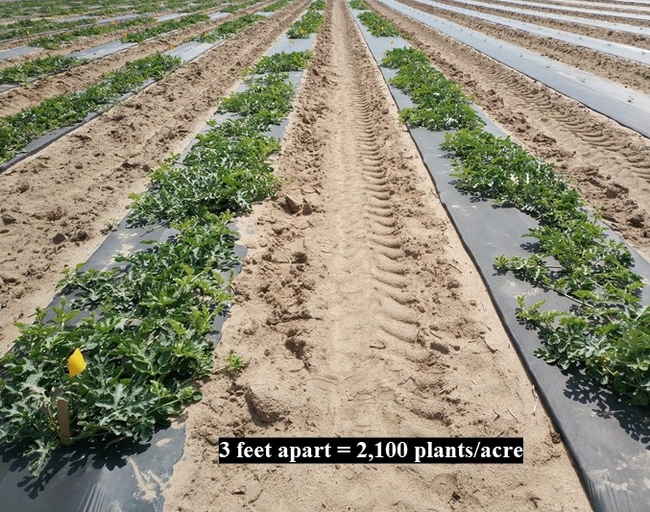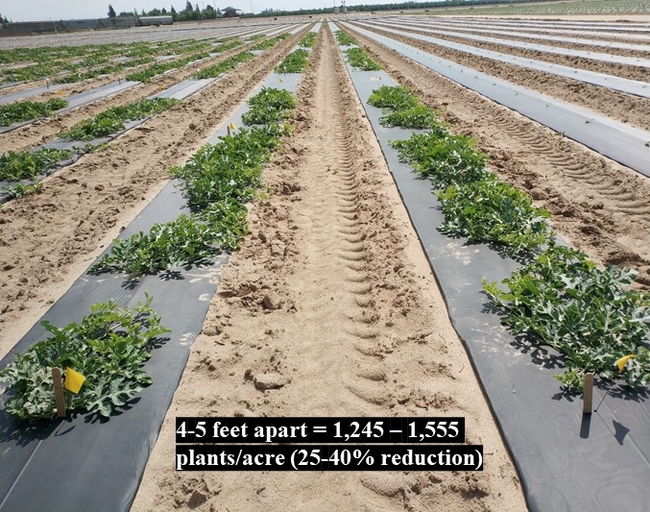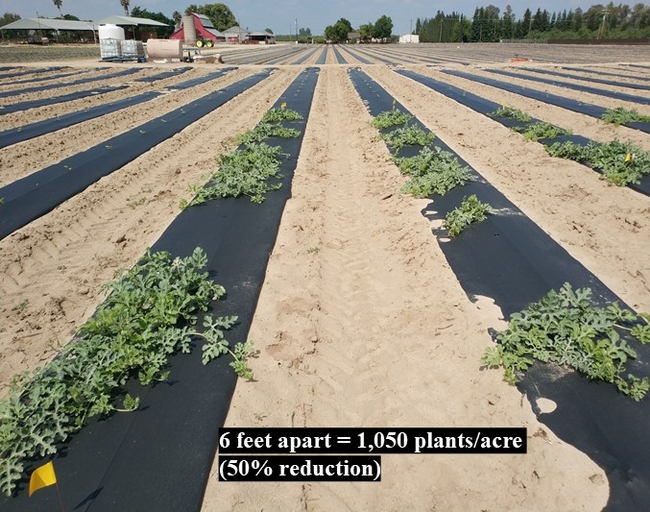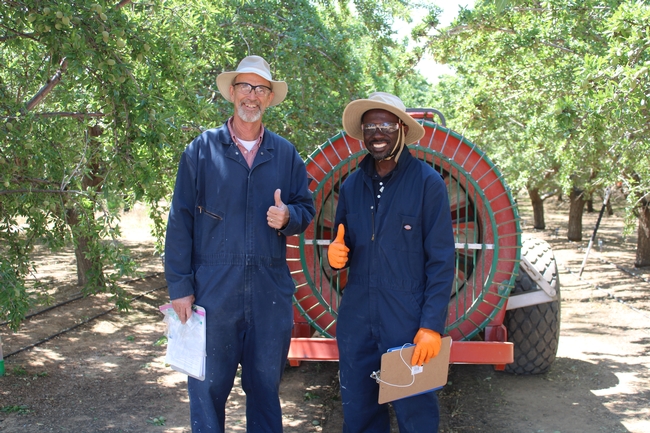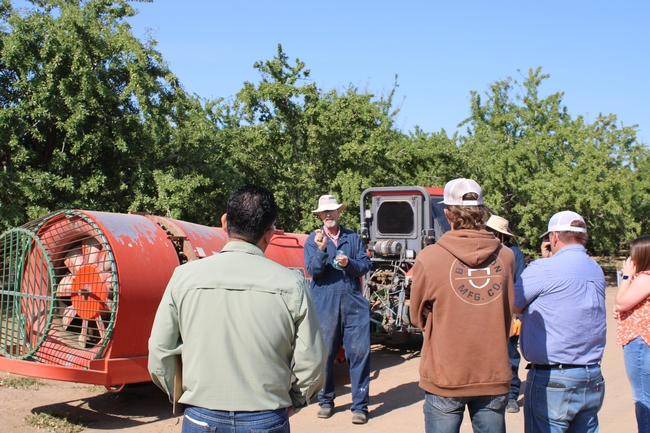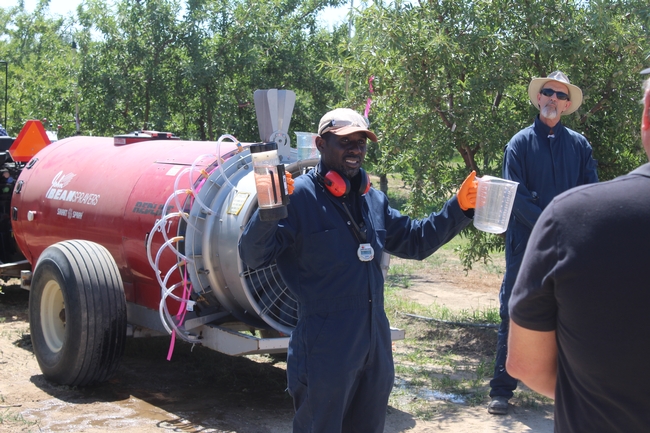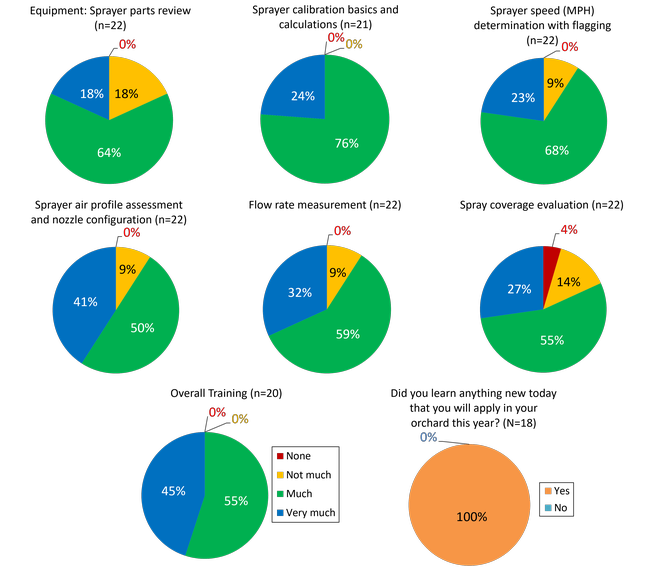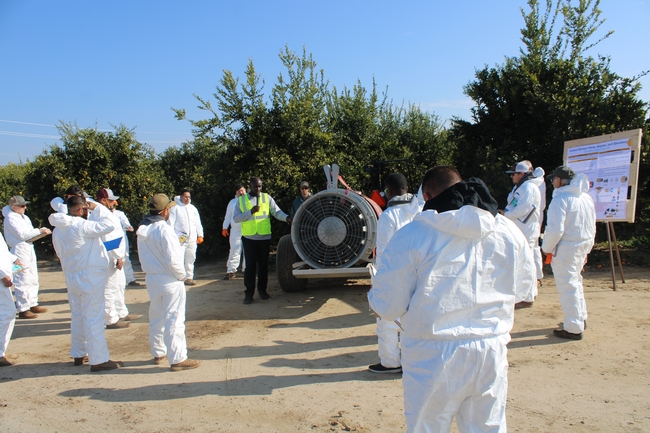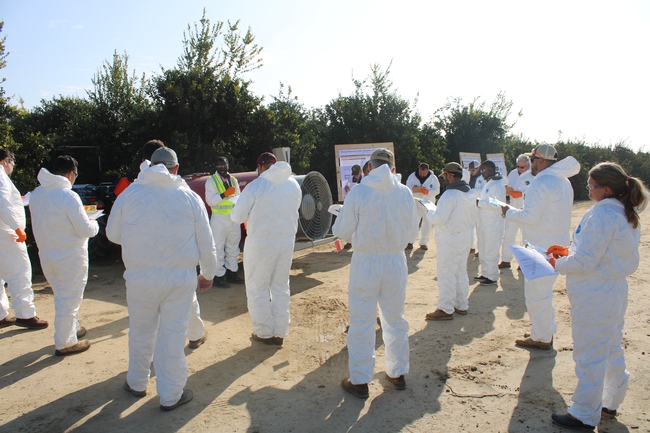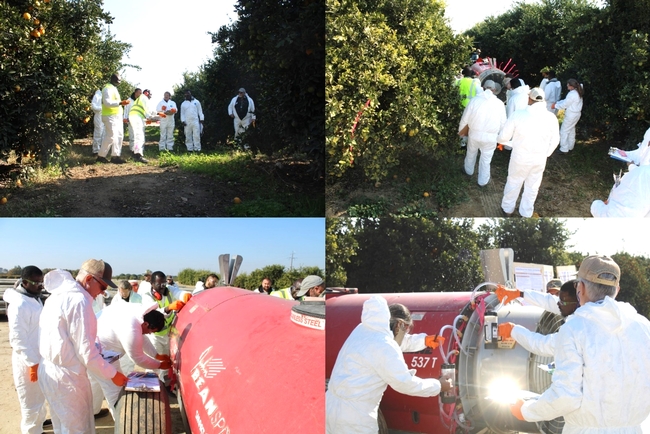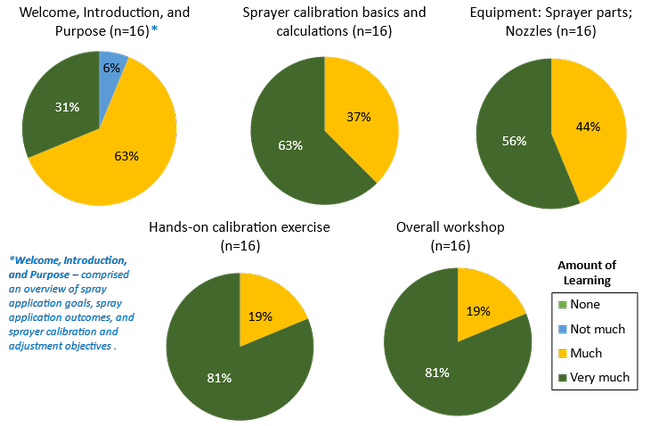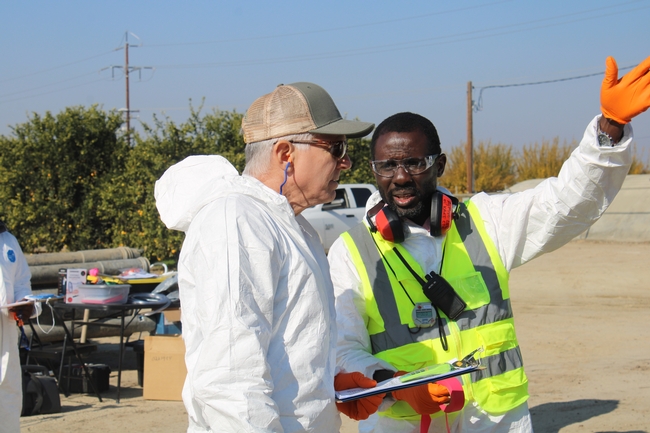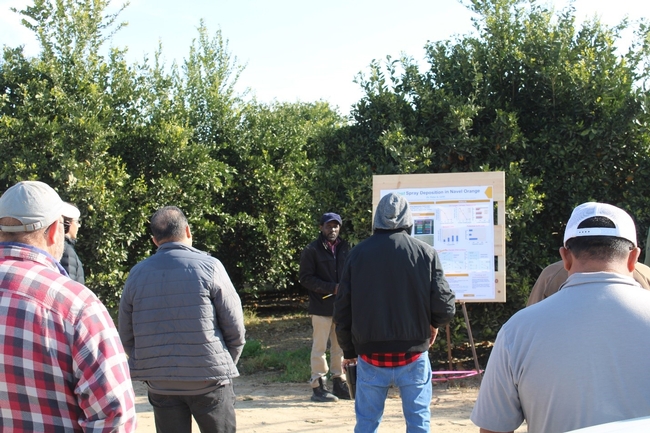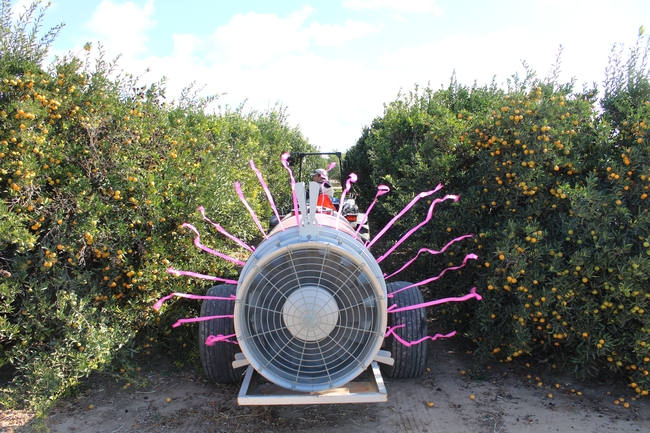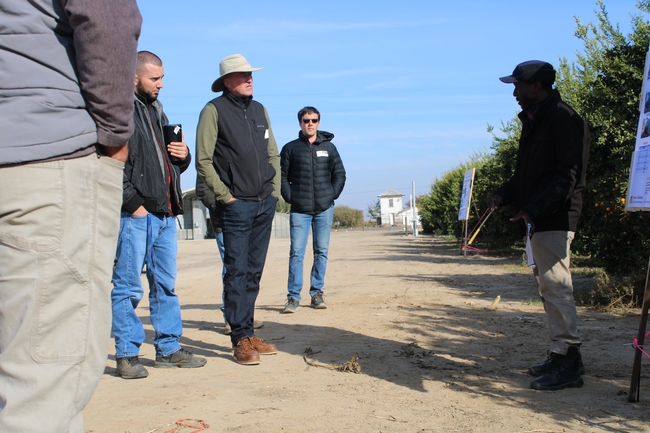- (Condition Change) Increased agriculture and forestry efficiency and profitability
- Author: Peter Ako Larbi
- Author: Franz J.A. Niederholzer
UC ANR supports California's almond crop protection workforce through Airblast Sprayer Calibration Trainings to maintain or improve their technical knowledge. 100% of participants reported both learning professional skills and their intent to adopt practices that can improve the sustainability and profitability of California ag.
The Issue
For efficient and effective pesticide spray application, all sprayers should be calibrated as often as necessary throughout the growing season of almonds, especially when dealing with orchards of different ages and sizes. Calibration is considered a best practice in pesticide spray application ensuring accurate application rates and adherence to pesticide labels which is the law. As such, proper understanding of sprayer calibration objectives and steps is needed to avoid using incorrect methods that give a false sense of accuracy. Educating growers and applicators in calibration methods will therefore empower them to ensure the use of properly calibrated sprayers well-adjusted to the target canopy to deliver maximum crop protection while minimizing pesticide loss.
How UC Delivers
In June 2023, UC ANR co-hosted two Calibration Safety & Compliance Training events, one for Northern California and the other for Central California, with the Almond Board of California (ABC), AgSafe Food and Farms (AgSafe), and the Western Agricultural Processors Association (WAPA). The Northern California training was held at the Nickels Soil Lab in Arbuckle, CA, while the Central California event took place at the UC's Kearney Agricultural Research and Extension (KARE) Center in Parlier, CA. The events were aimed at providing practical calibration training on how to prepare and calibrate airblast sprayers as well as compliance training such as how to manage required documents for pesticide applications. The 4.5-hour trainings included “Welcome” by the ABC, “Regulatory Update” by WAPA, “Calibration Training” by UC ANR, “Headquarters Compliance Training” by AgSafe, and “DPR Laws & Regulations Update” also by AgSafe. The DPR approved 4.0 hours of continuing education credits – 2.0 ‘Laws' and 2.0 ‘Other' – for qualifying participants. Overall, 50+ attendees participated in both events: 30+ in Arbuckle and 23 in Parlier.
The Calibration Training by UC ANR was a 2-hour practical session conducted in an almond orchard along with airblast sprayer demonstrations. It was presented in an interactive format allowing participants to interject with questions, comments, and observations. The Northern California training was led by UC Cooperative Extension advisor Dr. Franz Niederholzer in collaboration with UC Cooperative Extension specialist Dr. Peter Ako Larbi. Alternatively, the Central California training was led by Dr. Larbi in collaboration with Dr. Niederholzer. Both sections covered: “Sprayer parts review”; “Sprayer calibration basics and calculations”; “Sprayer speed determination”; “Sprayer air profile assessment and nozzle configuration”; “Flow rate measurement”; and “Spray coverage evaluation”. Staff from the Nickels Soil Lab, the Agricultural Application Engineering (AgAppE) Lab, and KARE Center provided Logistical, technical, and documentation support. The participants completed evaluation forms to provide feedback for just the Calibration Training section. Comments from the evaluation forms included…
“Very good class.”
“Great rapport with participants.”
The Impact
In all, 22 participants provided feedback on their learning for the combined Calibration Training sections for the Northern and Central California events. Overall, 100% reported “much” to “very much” learning from the combined Calibration Training sections indicating that they were very effective and provided participants with a great amount of learning. Likewise, 100% also indicated their intent to adopt the practices learned from the section. Looking at each section of the training, 82% reported learning “much” to “very much” from the “Sprayer parts review”, 100% the same for “Sprayer calibration basics and calculations”, 91% for “Sprayer speed determination with flagging”, 91% for “Sprayer air profile assessment and nozzle configuration”, 91% for “Flow rate measurement”, and 82% for “Spray coverage evaluation” (full breakdown of feedback by section in the graphic below). Additional written comments were mostly positive.
The needs assessment conducted by Dr. Larbi for his Agricultural Application Engineering Program in 2019 showed that 56% of perennial specialty crop growers and applicators in the San Joaquin Valley used airblast sprayers, 12% used tower sprayers, 15% used electrostatic mist blowers, and 17% used other sprayers. Also, 22% calibrated their sprayers 10 or more times a year, 32% calibrated 4-6 times, and 46% calibrated only 1-3 times a year. According to the California Pesticide Use Report, in 2021, 456,802 pesticide applications delivered 34,323,828 lbs. of pesticide across 24,147,968 acres of almond orchards. This amounts to 75.14 lbs. per application or 1.42 lbs. per acre. If even 1% of the application was overapplied and another 1% was underapplied due to using uncalibrated sprayers in the year (a conservative guess if nearly half of applicators only calibrate 1-3 years times a year), then 686,477 lbs would have been misapplied leading to either reduced pest control or increased pesticide loading on the environment. This number is very significant considering that the situation does not apply to only almond production. Thus, by increasing the competency of California's almond crop protection workforce for properly calibrating sprayers as a best practice, UC ANR potentially improved environmental sustainability.
UCCE academics Dr. Niederholzer and Dr. Larbi have an extended collaboration in providing spray application and sprayer calibration training in both Northern and Central California since 2019. The results presented here exemplify the impact of such trainings. Expanding this collaboration to include industry stakeholders reaches other audiences, potentially new participants, and increases the extent of impact. UC ANR will continue to support California agriculture through such trainings and the dissemination of science-based information to promote operational efficiency and profitability.
- Author: Peter Ako Larbi
UC ANR supports California's crop protection workforce to become more qualified through hands-on Airblast Sprayer Calibration Training. 100% of participants reported learning professional skills that also can improve the sustainability and profitability of California ag.
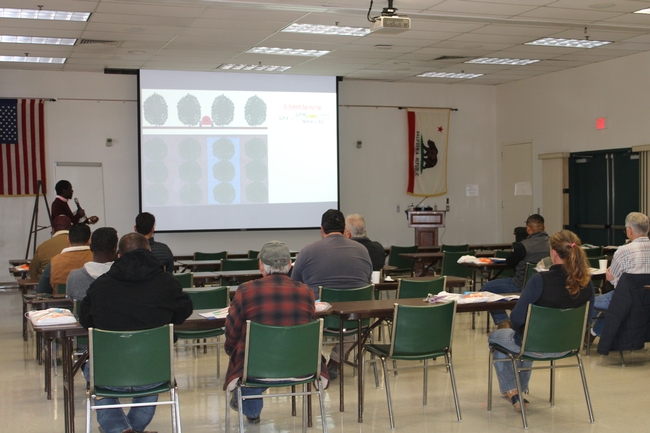
The Issue
As a best practice in pesticide spray application, growers and pesticide applicators should calibrate their sprayers to ensure accurate application rates and compliance with the law as represented by pesticide labels. However, proper understanding of sprayer calibration objectives and steps is needed to avoid a false sense of accuracy using incorrect methods. Educating growers and applicators in calibration methods will therefore empower them to ensure the use of properly calibrated sprayers well-adjusted to the target canopy to minimize pesticide waste and drift loss.
How UC Delivers
A half-day “Airblast Sprayer Calibration Training” was conducted in November 2022 at the Kearney Agricultural Research and Extension (KARE) Center. The in-person extension education event was supported by a California Department of Pesticide Regulation (DPR) grant. It involved classroom and field exercises focused on axial airblast spray applications directed to tree and vine canopies. The training was instructed by Dr. Peter Ako Larbi and assisted by his postdoc scholar Dr. Abiodun Abioye, with logistical support from his Agricultural Application Engineering (AgAppE) Lab and KARE Center personnel. It covered the basic steps and calculations involved in sprayer calibration, with practical follow up via hands-on demonstrations in the field. The DPR approved 3.5 hours of continuing education credits in ‘Other' category for qualifying participants. Sixteen participants were in attendance consisting of growers, applicators/operators, pest control advisors/certified crop advisors, scientists/researchers, and others.
The training started with classroom instruction covering “Welcome, Introduction, and Purpose” (comprising an overview of spray application goals, spray application outcomes, and sprayer calibration and adjustment objectives) and “Sprayer calibration basics and calculations” by Dr. Larbi. It then transitioned to in-field setting in a citrus block in an interactive format allowing participants to interject with questions, comments, and observations. With active participant involvement, the field experience included a presentation on “Sprayer Equipment Parts/Nozzles” by Dr. Abioye, hands-on exercises covering the calibration steps led by Dr. Larbi, a wrap-up discussion and answering of additional questions, and ended by evaluating participant learning. Engaging participants in various hands-on activities corresponding to the recommended calibration steps was intended to reinforce their learning. The spray equipment was operated by KARE Center staff research associate Ryan Puckett.
“Really helped me understand calibration much better.”
“Excellent speakers, demonstrators, trainers.”
The Impact
The participants were fully engaged throughout the training, and all (100%) provided feedback on their learning. Overall, those who reported gaining “much” to “very much” learning are: 94% for “Welcome, Introduction, and Purpose”; 100% for “Sprayer calibration basics and calculations”; 100% for “Equipment: Sprayer parts/Nozzles”; and 100% for “Hands-on calibration exercise”. On average, 97% reported gaining such learning in the classroom portion and 100% in the field. Overall, 100% reported “much” to “very much” learning from the entire training, indicating that it was very effective and provided participants with a great amount of learning. Additional written comments were mostly positive, and many participants verbally expressed their appreciation for the thoroughness of the training.
Dr. Larbi and his AgAppE Program plan to continue providing similar trainings in the future on both ongoing and need bases to arm his clientele with science-based knowledge and skills that will promote their operational efficiency and profitability.
According to the 2021 California Pesticide Use Report, 82,550,620 lbs. of pesticide was used in 941,751 applications for the top five (5) crops in all counties in the San Joaquin Valley covering 45,087,167 acres. Eighty-nine (89) percent of the quantity was applied on 39,742,883 acres of perennial specialty crops, which are the systems of primary focus for Dr. Larbi and his AgAppE program, amounting to 79.38 lbs. per application or 2.34 lbs per acre. Moreover, Dr. Larbi's 2019 Agricultural Application Engineering Program needs assessment revealed that only 22% of growers and applicators calibrated their sprayers 10 or more times a year, 32% calibrated 4-6 times, and 46% calibrated only 1-3 times a year. Hence, assuming a mere 1% of the application done in perennial specialty crop in 2021 was overapplied and another 1% was underapplied due to using uncalibrated sprayers, then 1,467,100 lbs would have been misapplied leading to either reduced pest control or increased pesticide loading on the environment. This number is very significant considering that the situation does not apply to only the top five crops. Thus, by increasing the competency of California's crop protection workforce for properly calibrating sprayers as a best practice, the AgAppE Program potentially increased workforce retention, improved environmental sustainability, and increased the profitability of growers.
- Author: Peter Ako Larbi
Upon attending the Citrus Spray Field Day in November 2022 at the Kearney Agricultural Research and Extension (KARE) Center, 93% of participants reported learning much or very much about spray application best practices, which can lead to increased agricultural efficiency.
The Issue
Because of the complex nature of spray application under field conditions, growers and pesticide applicators have difficulty in recognizing or using best practices that result in desired application efficiencies. Therefore, applications often fall short. Developing and disseminating science-based recommendations from field trials and decision support tools to assist with pesticide spray application decisions will reduce the guesswork, improve efficiency, and promote effective pest control.
How UC Delivers
The Citrus Spray Field Day was a 4-hour classroom and field meeting that discussed pesticide application effectiveness, focusing on axial airblast spray applications directed to citrus (and other tree and vine) canopies. It was instructed by Dr. Peter Ako Larbi with support from hisAgricultural Application Engineering (AgAppE) Lab andKARE Center personnel. Discussions covered techniques and considerations for optimizing spray deposition and coverage as well as for minimizing pesticide drift. Sixteen participants were in attendance consisting of growers, applicators/operators, pest control advisers/certified crop advisors, regulators/policymakers, scientists/researchers, and others.
Starting with classroom instruction, it covered “Welcome, Introduction, and Purpose” and “Introduction to ‘Airblast Spray Advisor' decision support tool”, transitioning to field instruction which included “Airblast spray demonstration”, “Spray deposition in mandarin” and “Spray deposition in navel orange”. Continuing back in the classroom with sessions on “Spray drift potential in citrus applications” and “Evaluating ‘Airblast Spray Advisor' deposition predictions”, Citrus Spray Field Day ended by evaluating participant learning with approximately 94% response rate.
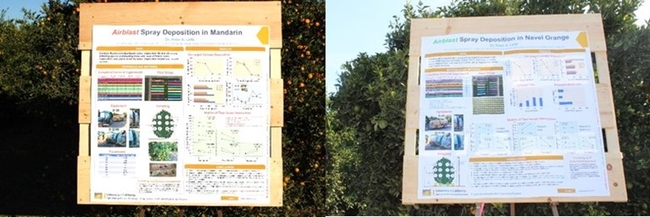
The Impact
The participants were fully engaged throughout the training. Overall, those who reported gaining “much” to “very much” learning are as follows: 87% for “Welcome, Introduction, and Purpose”; 80% for “Introduction to ‘Airblast Spray Advisor' decision support tool”; 87% for “Airblast spray demonstration”; 93% for “Spray deposition in mandarin”; 94% for “Spray deposition in navel orange”; and 87% in “Spray drift potential in citrus applications”. On average, about 85% reported learning gains in the classroom portion and about 91% reported learning gains in the field. Overall, 93% reported “much” to “very much” learning for the entire field day, showing that the training was very effective and provided participants with a great amount of learning.
Dr. Larbi and his AgAppE Program plan to continue providing similar trainings in the future on both ongoing and need bases to arm his clientele with science-based knowledge that will promote their operational efficiency and profitability.
- Author: Niamh Quinn
A UCCE advisor's short, effective communications on rodent management techniques helped San Diego County nurseries prevent crop losses and excess labor costs and pesticide use.
The Issue
Rodents are known to cause extensive damage to different agricultural crops worldwide. In San Diego County, nursery and cut flower products account for the commodity with the highest reported dollar value and the highest dollar value per acre. In 2020, nursery and cut flower products had a total reported value of $1,274,784,274 and accounted for 70% of San Diego's agricultural commodities. Rodents have been reported to not only directly damage nursery crops by chewing directly on ornamental trees, seeds, seedlings, and bulbs, but they also cause extensive damage to drip irrigation systems.
How UC Delivers
UCCE Advisor Niamh Quinn's focus is on human-to-wildlife conflict, and rodents are what she knows best. When two members of the nursery and cut flower community in San Diego County reached out to her about rodent management issues, she was able to deliver practical, science-based solutions. One grower was experiencing issues where mice were damaging significant amounts of bulbs used to grow blooming plants. Another grower had an issue where mice were chewing irrigation lines used to provide water to cut flowers. Additionally, if you are not using the right pesticide, or the appropriate application method, pesticide use can be highly inflated. Thus, it is critical to offer science-based advice on pesticide use and alternative methods.
The Impact
UCCE's technical assistance provided to the growers prevented significant crop loss. One grower estimated that the information on rodent management prevented $50,000 a year in crop loss, while the other estimated that their crop yield increased by 5% due to improved crop uniformity and height because rodents were no longer damaging drip.
Both growers reported significant cost reductions in labor. One grower has saved over $20,000 in labor costs due to a significant reduction in the amount of pesticide applied. The 90% reduction in pesticide applied not only saved the grower money on the labor needed to apply the product, but approximately $30,000 reduction in cost because less pesticide needed to be purchased. The other grower saved approximately $3,100 on the labor needed to repair drip irrigation that was being damaged by rodents.
These outcomes demonstrate how UCCE Advisors' extension programs contribute to increased agriculture and efficiency and profitability as part of UC ANR's commitment to promoting economic prosperity in California and also demonstrate a commitment to increased ecological sustainability of agriculture. Mike Mellano, CEO of Mellano & Company in San Diego says, “In today's fast paced and ever-changing world, it is very difficult, if not impossible for farmers/growers to stay on the cutting edge of every aspect. It is great to know that we have Cooperative Extension to educate us and help keep us innovative and sustainable. It seems that every day we have a new challenge, and being able to call or email an advisor to get the latest and greatest is the key to our ability to continue to stay in business and provide jobs and opportunities for our teams!"
- Author: Zheng Wang
UC ANR research on watermelon grafting helps growers produce 15-20% more watermelons while using 25-40% fewer plants than the traditional system under the same amount of water and fertilizers, contributing to economic prosperity for the agricultural sector.
The Issue
As the statewide water scarcity and rising inflation hit the California agriculture, food production with reduced inputs while maintaining productivity and controlling production cost heighten the necessity of using environmentally-sustainable farming practices. For watermelon growers, grafting, a thousand-year-old practice, has been recognized as a such practice to tackle the problems according to scientific literature. However, the adoption on grafting has been low among California watermelon growers despite the benefits being well-known. Therefore, strengthening growers' confidence with this ancient production tool is crucial.
How UC Delivers
Extensive field visits to watermelon growers, nursery, and seed industries were conducted to understand the barrier of adopting watermelon grafting starting in 2018. Results from the interviews indicated that the increase of production cost was the biggest concern when growers considered watermelon grafting. Further investigations showed that growers pay 2.5 to 4 times more per acre for producing grafted transplants compared to non-grafted watermelons.
In addition to yielding more fruit, grafted fields should also use fewer plants to compensate for the higher cost. Since 2019, field experiments were conducted in the San Joaquin Valley to test the horticultural and economic potential of growing grafted watermelons in wider spacings. A total of eight rootstocks and four scions were grafted into 32 combinations, which were planted into the regular three feet, and wider spacings of four to five and six feet apart. The results indicated that grafted watermelons planted with the four to five feet in-row spacing balanced the best among yield enhancement, fruit quality, and control of cost. Study progress and findings were shared periodically with the cooperative growers and discussed with the watermelon industry. The information was also reported in extension articles and at various extension and scientific conferences.
The Impact
With the four to five feet in-row spacing adopted widely, the cost for grafted transplants was reduced up to $800 per acre. Furthermore, stronger confidence with grafting has led to the increase of planted acreage of grafted watermelons from less than 250 acres in 2018 to over 1,500 acres in 2021. According to the field observations, growers reported that, on average, their successfully grafted fields produced 15-20% more watermelons than non-grafted fields while using up to 40% fewer plants and the same amount of water and fertilizers. For local greenhouses, customer orders of grafted watermelon transplants increased more than 10 times in 2022 compared to 2018. These savings and increases in revenue demonstrate UC ANR's commitment to its public value of promoting economic prosperity.
